A Comprehensive Study of Organizational Dividend Policy Development
VerifiedAdded on 2023/04/06
|10
|1863
|175
Essay
AI Summary
This essay provides a comprehensive analysis of organizational dividend policy, emphasizing its role in shareholder wealth maximization and economic growth. It explores key issues related to dividend policy, investigates current trends, and examines the managerial decisions that drive policy development. The essay reviews relevant literature, highlighting the importance of dividend policy in attracting investors and reinvestment opportunities. It also discusses the impact of factors such as profitability, growth, and market competency on dividend decisions. The study employs secondary data and an explanatory design method to provide a balanced understanding of the topic, concluding that a well-defined dividend policy is crucial for organizational sustainability and investor confidence. Desklib offers this assignment solution along with a wide array of study resources.
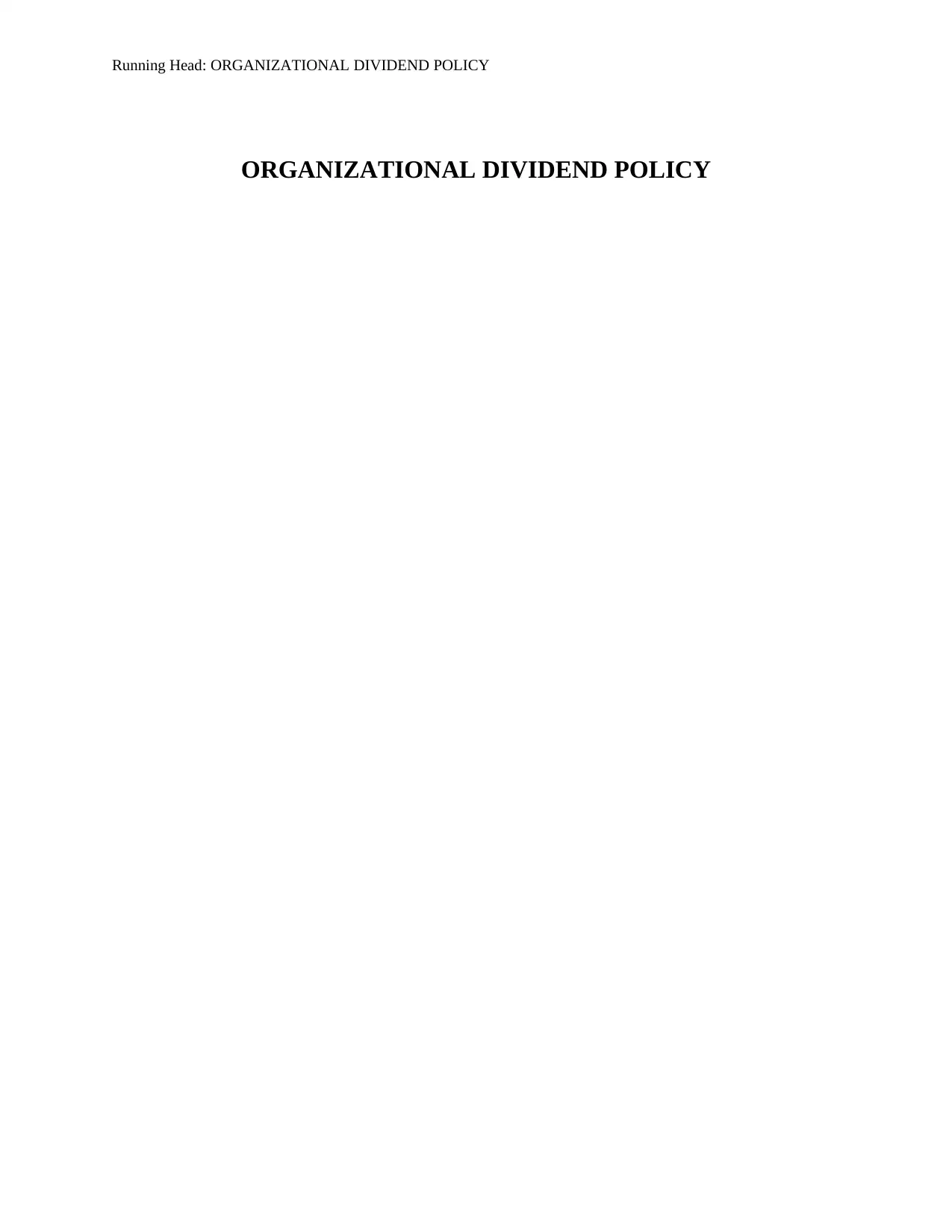
Running Head: ORGANIZATIONAL DIVIDEND POLICY
ORGANIZATIONAL DIVIDEND POLICY
ORGANIZATIONAL DIVIDEND POLICY
Paraphrase This Document
Need a fresh take? Get an instant paraphrase of this document with our AI Paraphraser
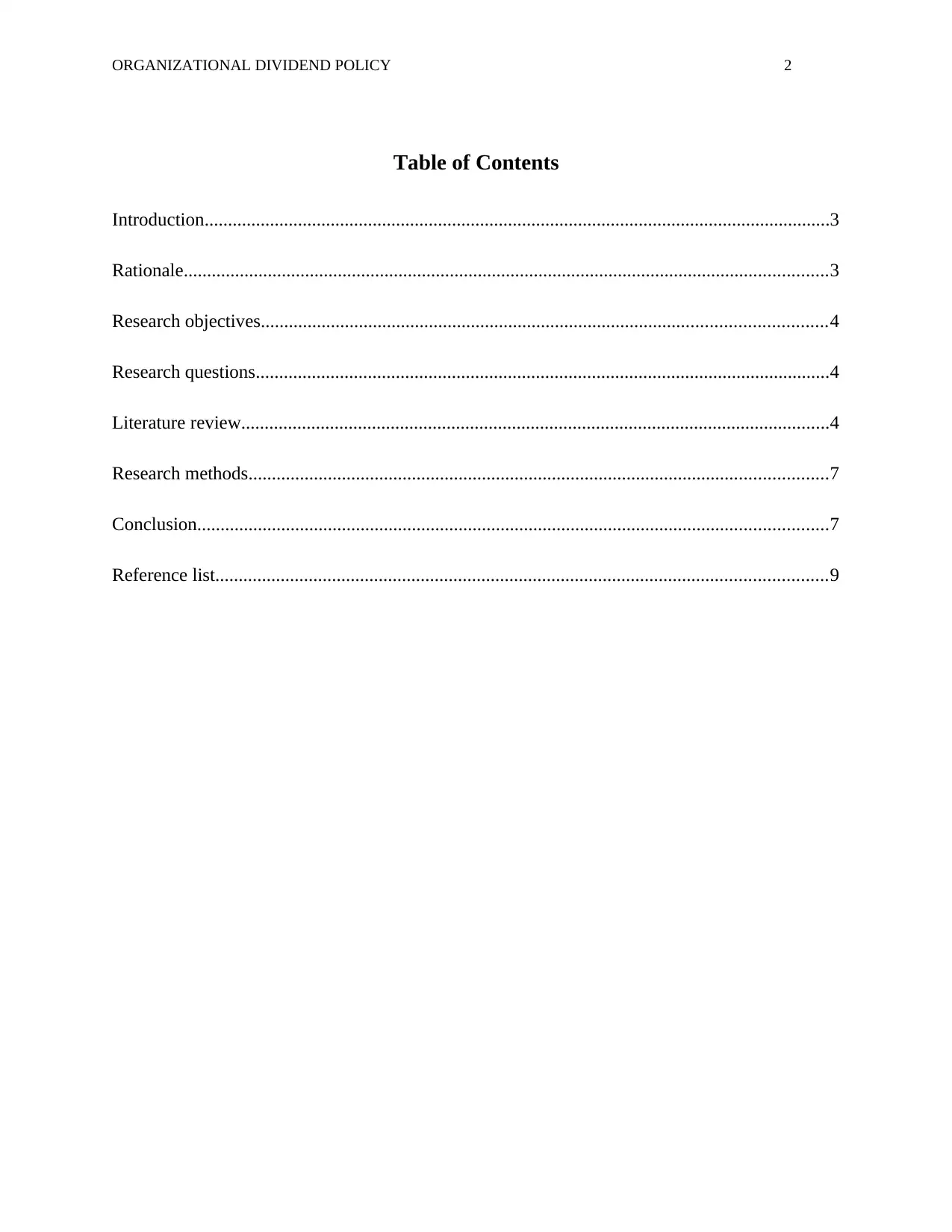
ORGANIZATIONAL DIVIDEND POLICY 2
Table of Contents
Introduction......................................................................................................................................3
Rationale..........................................................................................................................................3
Research objectives.........................................................................................................................4
Research questions...........................................................................................................................4
Literature review..............................................................................................................................4
Research methods............................................................................................................................7
Conclusion.......................................................................................................................................7
Reference list...................................................................................................................................9
Table of Contents
Introduction......................................................................................................................................3
Rationale..........................................................................................................................................3
Research objectives.........................................................................................................................4
Research questions...........................................................................................................................4
Literature review..............................................................................................................................4
Research methods............................................................................................................................7
Conclusion.......................................................................................................................................7
Reference list...................................................................................................................................9
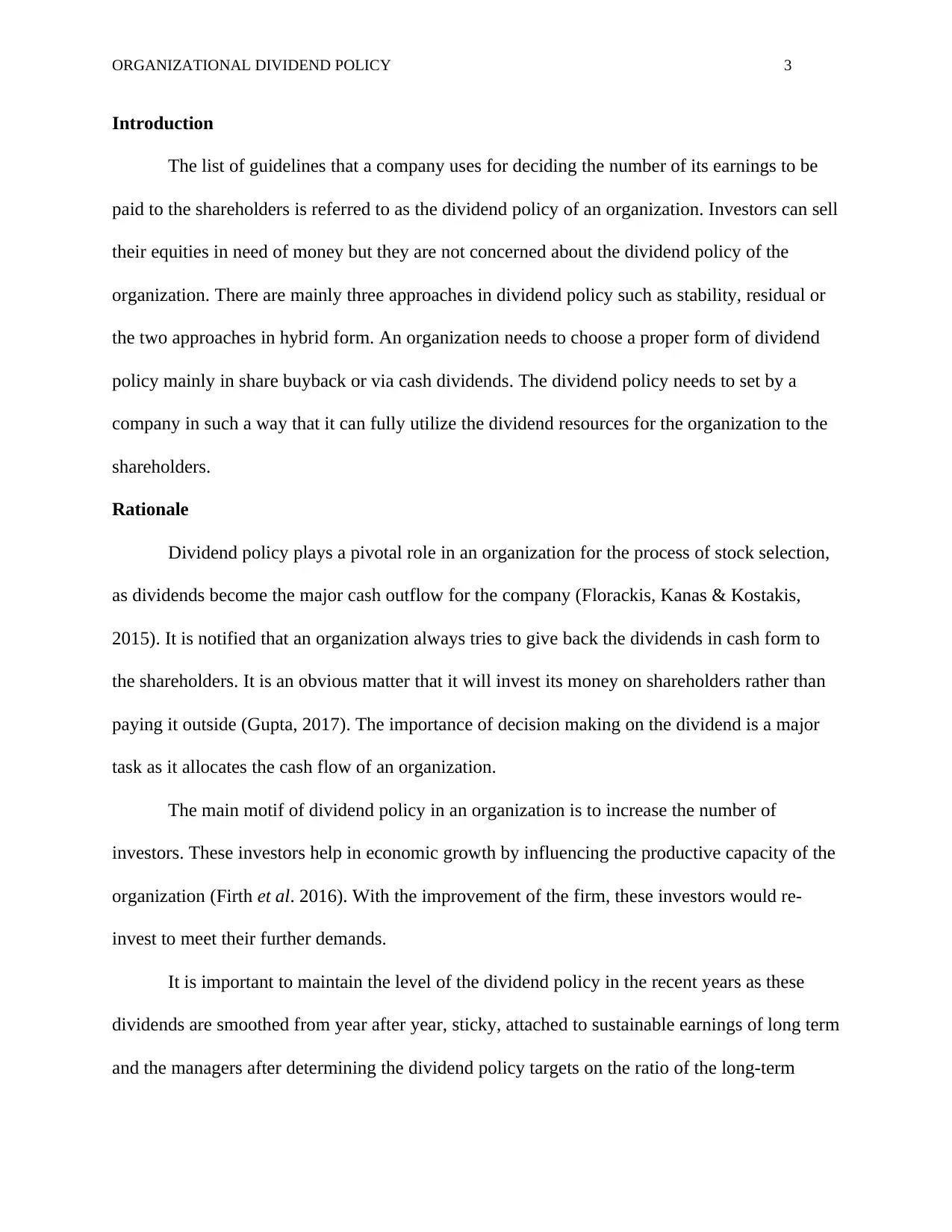
ORGANIZATIONAL DIVIDEND POLICY 3
Introduction
The list of guidelines that a company uses for deciding the number of its earnings to be
paid to the shareholders is referred to as the dividend policy of an organization. Investors can sell
their equities in need of money but they are not concerned about the dividend policy of the
organization. There are mainly three approaches in dividend policy such as stability, residual or
the two approaches in hybrid form. An organization needs to choose a proper form of dividend
policy mainly in share buyback or via cash dividends. The dividend policy needs to set by a
company in such a way that it can fully utilize the dividend resources for the organization to the
shareholders.
Rationale
Dividend policy plays a pivotal role in an organization for the process of stock selection,
as dividends become the major cash outflow for the company (Florackis, Kanas & Kostakis,
2015). It is notified that an organization always tries to give back the dividends in cash form to
the shareholders. It is an obvious matter that it will invest its money on shareholders rather than
paying it outside (Gupta, 2017). The importance of decision making on the dividend is a major
task as it allocates the cash flow of an organization.
The main motif of dividend policy in an organization is to increase the number of
investors. These investors help in economic growth by influencing the productive capacity of the
organization (Firth et al. 2016). With the improvement of the firm, these investors would re-
invest to meet their further demands.
It is important to maintain the level of the dividend policy in the recent years as these
dividends are smoothed from year after year, sticky, attached to sustainable earnings of long term
and the managers after determining the dividend policy targets on the ratio of the long-term
Introduction
The list of guidelines that a company uses for deciding the number of its earnings to be
paid to the shareholders is referred to as the dividend policy of an organization. Investors can sell
their equities in need of money but they are not concerned about the dividend policy of the
organization. There are mainly three approaches in dividend policy such as stability, residual or
the two approaches in hybrid form. An organization needs to choose a proper form of dividend
policy mainly in share buyback or via cash dividends. The dividend policy needs to set by a
company in such a way that it can fully utilize the dividend resources for the organization to the
shareholders.
Rationale
Dividend policy plays a pivotal role in an organization for the process of stock selection,
as dividends become the major cash outflow for the company (Florackis, Kanas & Kostakis,
2015). It is notified that an organization always tries to give back the dividends in cash form to
the shareholders. It is an obvious matter that it will invest its money on shareholders rather than
paying it outside (Gupta, 2017). The importance of decision making on the dividend is a major
task as it allocates the cash flow of an organization.
The main motif of dividend policy in an organization is to increase the number of
investors. These investors help in economic growth by influencing the productive capacity of the
organization (Firth et al. 2016). With the improvement of the firm, these investors would re-
invest to meet their further demands.
It is important to maintain the level of the dividend policy in the recent years as these
dividends are smoothed from year after year, sticky, attached to sustainable earnings of long term
and the managers after determining the dividend policy targets on the ratio of the long-term
⊘ This is a preview!⊘
Do you want full access?
Subscribe today to unlock all pages.

Trusted by 1+ million students worldwide
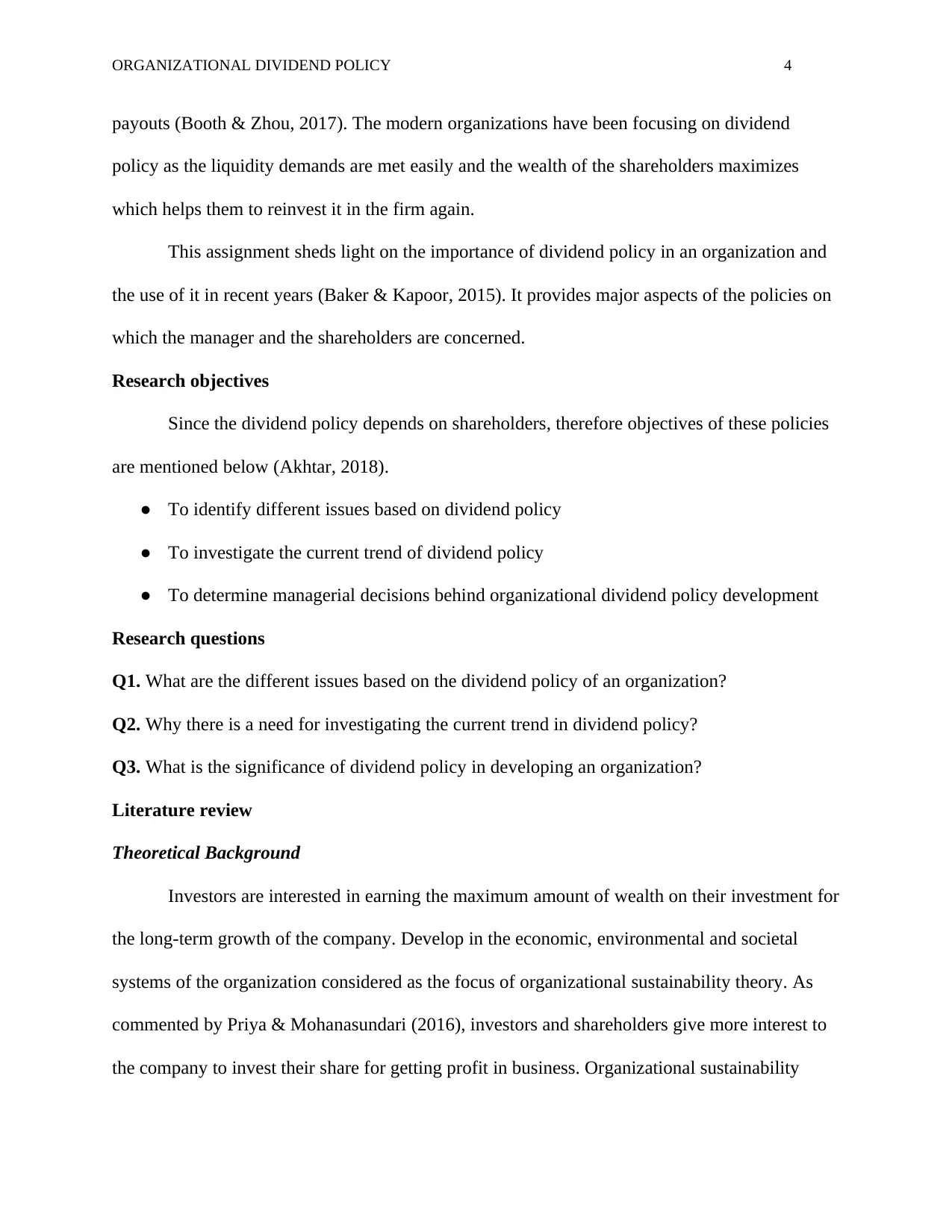
ORGANIZATIONAL DIVIDEND POLICY 4
payouts (Booth & Zhou, 2017). The modern organizations have been focusing on dividend
policy as the liquidity demands are met easily and the wealth of the shareholders maximizes
which helps them to reinvest it in the firm again.
This assignment sheds light on the importance of dividend policy in an organization and
the use of it in recent years (Baker & Kapoor, 2015). It provides major aspects of the policies on
which the manager and the shareholders are concerned.
Research objectives
Since the dividend policy depends on shareholders, therefore objectives of these policies
are mentioned below (Akhtar, 2018).
● To identify different issues based on dividend policy
● To investigate the current trend of dividend policy
● To determine managerial decisions behind organizational dividend policy development
Research questions
Q1. What are the different issues based on the dividend policy of an organization?
Q2. Why there is a need for investigating the current trend in dividend policy?
Q3. What is the significance of dividend policy in developing an organization?
Literature review
Theoretical Background
Investors are interested in earning the maximum amount of wealth on their investment for
the long-term growth of the company. Develop in the economic, environmental and societal
systems of the organization considered as the focus of organizational sustainability theory. As
commented by Priya & Mohanasundari (2016), investors and shareholders give more interest to
the company to invest their share for getting profit in business. Organizational sustainability
payouts (Booth & Zhou, 2017). The modern organizations have been focusing on dividend
policy as the liquidity demands are met easily and the wealth of the shareholders maximizes
which helps them to reinvest it in the firm again.
This assignment sheds light on the importance of dividend policy in an organization and
the use of it in recent years (Baker & Kapoor, 2015). It provides major aspects of the policies on
which the manager and the shareholders are concerned.
Research objectives
Since the dividend policy depends on shareholders, therefore objectives of these policies
are mentioned below (Akhtar, 2018).
● To identify different issues based on dividend policy
● To investigate the current trend of dividend policy
● To determine managerial decisions behind organizational dividend policy development
Research questions
Q1. What are the different issues based on the dividend policy of an organization?
Q2. Why there is a need for investigating the current trend in dividend policy?
Q3. What is the significance of dividend policy in developing an organization?
Literature review
Theoretical Background
Investors are interested in earning the maximum amount of wealth on their investment for
the long-term growth of the company. Develop in the economic, environmental and societal
systems of the organization considered as the focus of organizational sustainability theory. As
commented by Priya & Mohanasundari (2016), investors and shareholders give more interest to
the company to invest their share for getting profit in business. Organizational sustainability
Paraphrase This Document
Need a fresh take? Get an instant paraphrase of this document with our AI Paraphraser
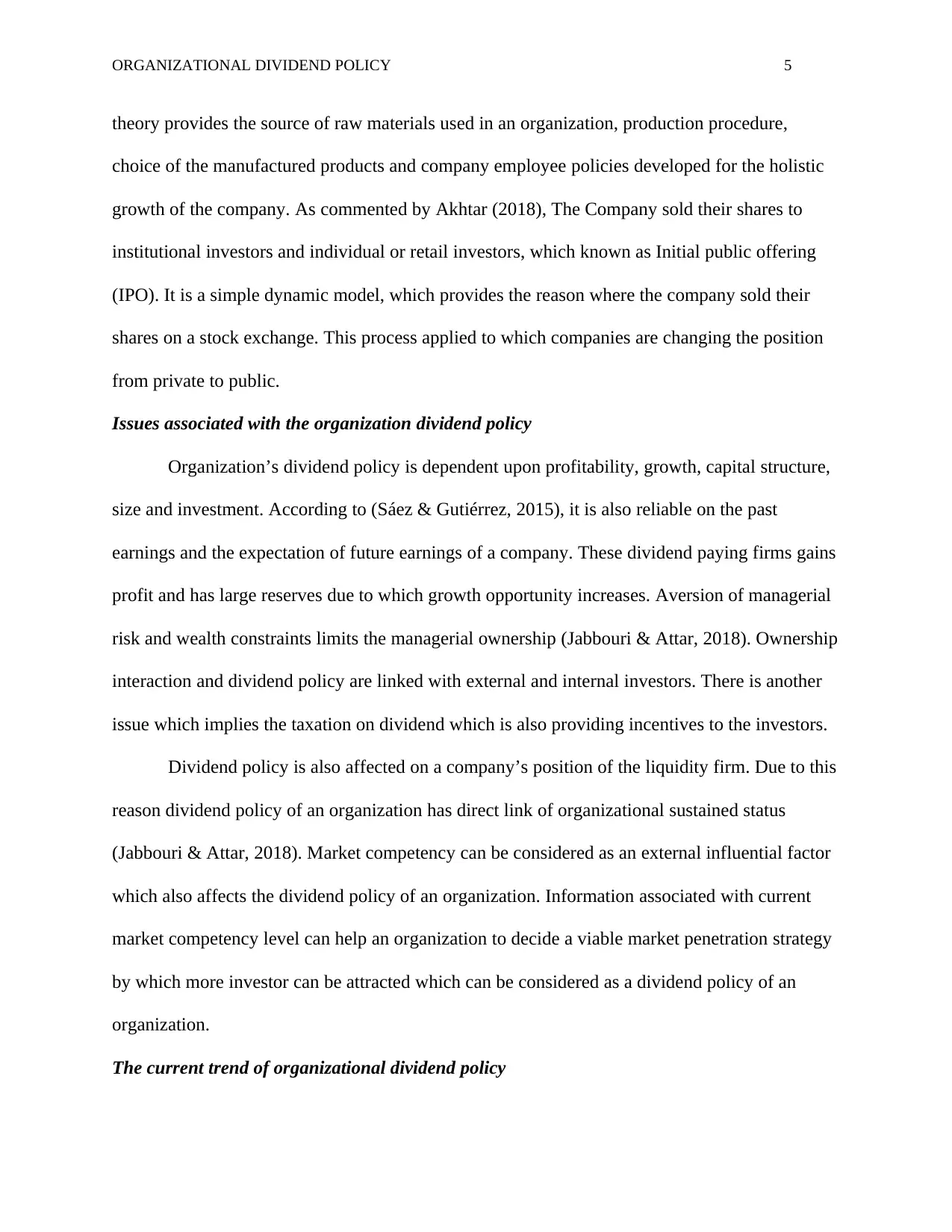
ORGANIZATIONAL DIVIDEND POLICY 5
theory provides the source of raw materials used in an organization, production procedure,
choice of the manufactured products and company employee policies developed for the holistic
growth of the company. As commented by Akhtar (2018), The Company sold their shares to
institutional investors and individual or retail investors, which known as Initial public offering
(IPO). It is a simple dynamic model, which provides the reason where the company sold their
shares on a stock exchange. This process applied to which companies are changing the position
from private to public.
Issues associated with the organization dividend policy
Organization’s dividend policy is dependent upon profitability, growth, capital structure,
size and investment. According to (Sáez & Gutiérrez, 2015), it is also reliable on the past
earnings and the expectation of future earnings of a company. These dividend paying firms gains
profit and has large reserves due to which growth opportunity increases. Aversion of managerial
risk and wealth constraints limits the managerial ownership (Jabbouri & Attar, 2018). Ownership
interaction and dividend policy are linked with external and internal investors. There is another
issue which implies the taxation on dividend which is also providing incentives to the investors.
Dividend policy is also affected on a company’s position of the liquidity firm. Due to this
reason dividend policy of an organization has direct link of organizational sustained status
(Jabbouri & Attar, 2018). Market competency can be considered as an external influential factor
which also affects the dividend policy of an organization. Information associated with current
market competency level can help an organization to decide a viable market penetration strategy
by which more investor can be attracted which can be considered as a dividend policy of an
organization.
The current trend of organizational dividend policy
theory provides the source of raw materials used in an organization, production procedure,
choice of the manufactured products and company employee policies developed for the holistic
growth of the company. As commented by Akhtar (2018), The Company sold their shares to
institutional investors and individual or retail investors, which known as Initial public offering
(IPO). It is a simple dynamic model, which provides the reason where the company sold their
shares on a stock exchange. This process applied to which companies are changing the position
from private to public.
Issues associated with the organization dividend policy
Organization’s dividend policy is dependent upon profitability, growth, capital structure,
size and investment. According to (Sáez & Gutiérrez, 2015), it is also reliable on the past
earnings and the expectation of future earnings of a company. These dividend paying firms gains
profit and has large reserves due to which growth opportunity increases. Aversion of managerial
risk and wealth constraints limits the managerial ownership (Jabbouri & Attar, 2018). Ownership
interaction and dividend policy are linked with external and internal investors. There is another
issue which implies the taxation on dividend which is also providing incentives to the investors.
Dividend policy is also affected on a company’s position of the liquidity firm. Due to this
reason dividend policy of an organization has direct link of organizational sustained status
(Jabbouri & Attar, 2018). Market competency can be considered as an external influential factor
which also affects the dividend policy of an organization. Information associated with current
market competency level can help an organization to decide a viable market penetration strategy
by which more investor can be attracted which can be considered as a dividend policy of an
organization.
The current trend of organizational dividend policy
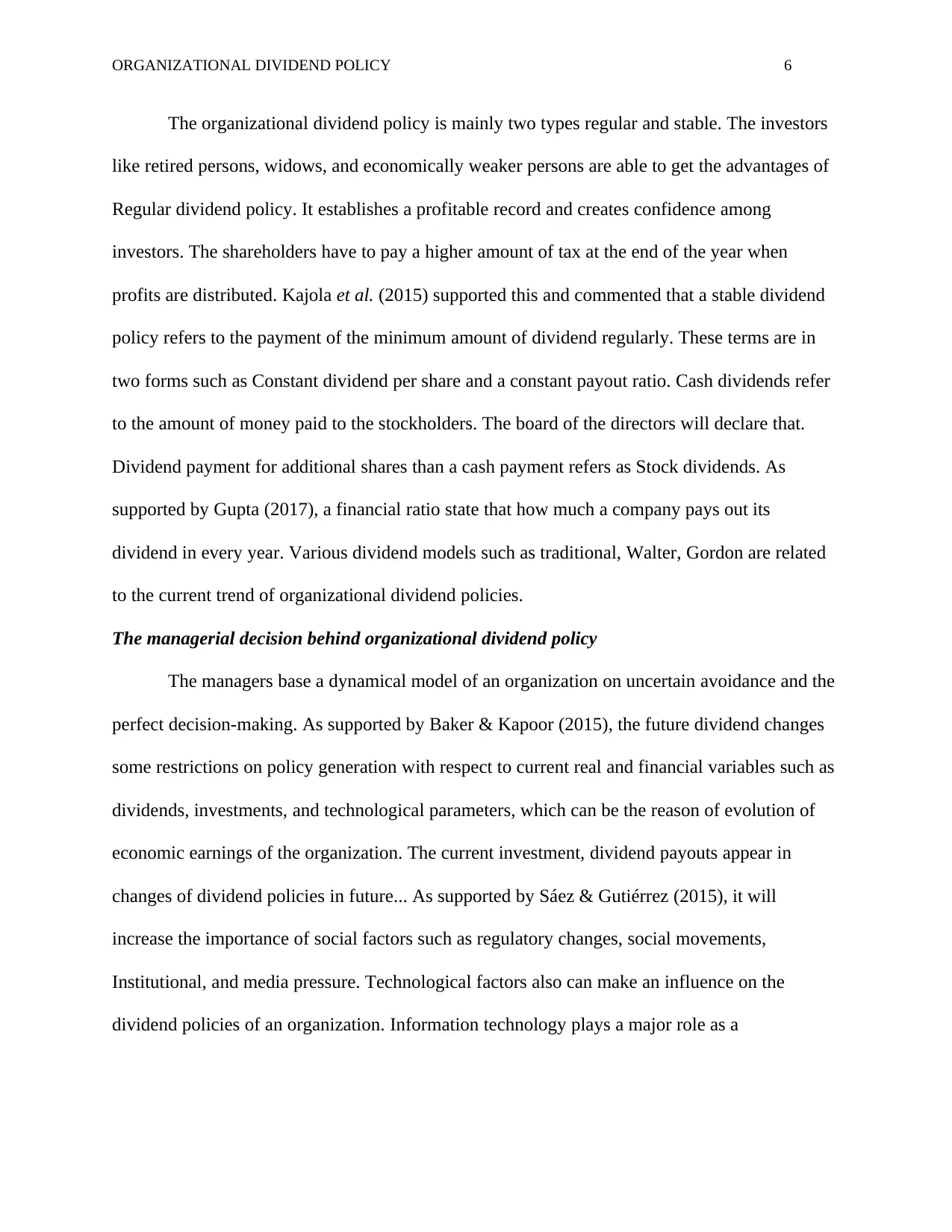
ORGANIZATIONAL DIVIDEND POLICY 6
The organizational dividend policy is mainly two types regular and stable. The investors
like retired persons, widows, and economically weaker persons are able to get the advantages of
Regular dividend policy. It establishes a profitable record and creates confidence among
investors. The shareholders have to pay a higher amount of tax at the end of the year when
profits are distributed. Kajola et al. (2015) supported this and commented that a stable dividend
policy refers to the payment of the minimum amount of dividend regularly. These terms are in
two forms such as Constant dividend per share and a constant payout ratio. Cash dividends refer
to the amount of money paid to the stockholders. The board of the directors will declare that.
Dividend payment for additional shares than a cash payment refers as Stock dividends. As
supported by Gupta (2017), a financial ratio state that how much a company pays out its
dividend in every year. Various dividend models such as traditional, Walter, Gordon are related
to the current trend of organizational dividend policies.
The managerial decision behind organizational dividend policy
The managers base a dynamical model of an organization on uncertain avoidance and the
perfect decision-making. As supported by Baker & Kapoor (2015), the future dividend changes
some restrictions on policy generation with respect to current real and financial variables such as
dividends, investments, and technological parameters, which can be the reason of evolution of
economic earnings of the organization. The current investment, dividend payouts appear in
changes of dividend policies in future... As supported by Sáez & Gutiérrez (2015), it will
increase the importance of social factors such as regulatory changes, social movements,
Institutional, and media pressure. Technological factors also can make an influence on the
dividend policies of an organization. Information technology plays a major role as a
The organizational dividend policy is mainly two types regular and stable. The investors
like retired persons, widows, and economically weaker persons are able to get the advantages of
Regular dividend policy. It establishes a profitable record and creates confidence among
investors. The shareholders have to pay a higher amount of tax at the end of the year when
profits are distributed. Kajola et al. (2015) supported this and commented that a stable dividend
policy refers to the payment of the minimum amount of dividend regularly. These terms are in
two forms such as Constant dividend per share and a constant payout ratio. Cash dividends refer
to the amount of money paid to the stockholders. The board of the directors will declare that.
Dividend payment for additional shares than a cash payment refers as Stock dividends. As
supported by Gupta (2017), a financial ratio state that how much a company pays out its
dividend in every year. Various dividend models such as traditional, Walter, Gordon are related
to the current trend of organizational dividend policies.
The managerial decision behind organizational dividend policy
The managers base a dynamical model of an organization on uncertain avoidance and the
perfect decision-making. As supported by Baker & Kapoor (2015), the future dividend changes
some restrictions on policy generation with respect to current real and financial variables such as
dividends, investments, and technological parameters, which can be the reason of evolution of
economic earnings of the organization. The current investment, dividend payouts appear in
changes of dividend policies in future... As supported by Sáez & Gutiérrez (2015), it will
increase the importance of social factors such as regulatory changes, social movements,
Institutional, and media pressure. Technological factors also can make an influence on the
dividend policies of an organization. Information technology plays a major role as a
⊘ This is a preview!⊘
Do you want full access?
Subscribe today to unlock all pages.

Trusted by 1+ million students worldwide
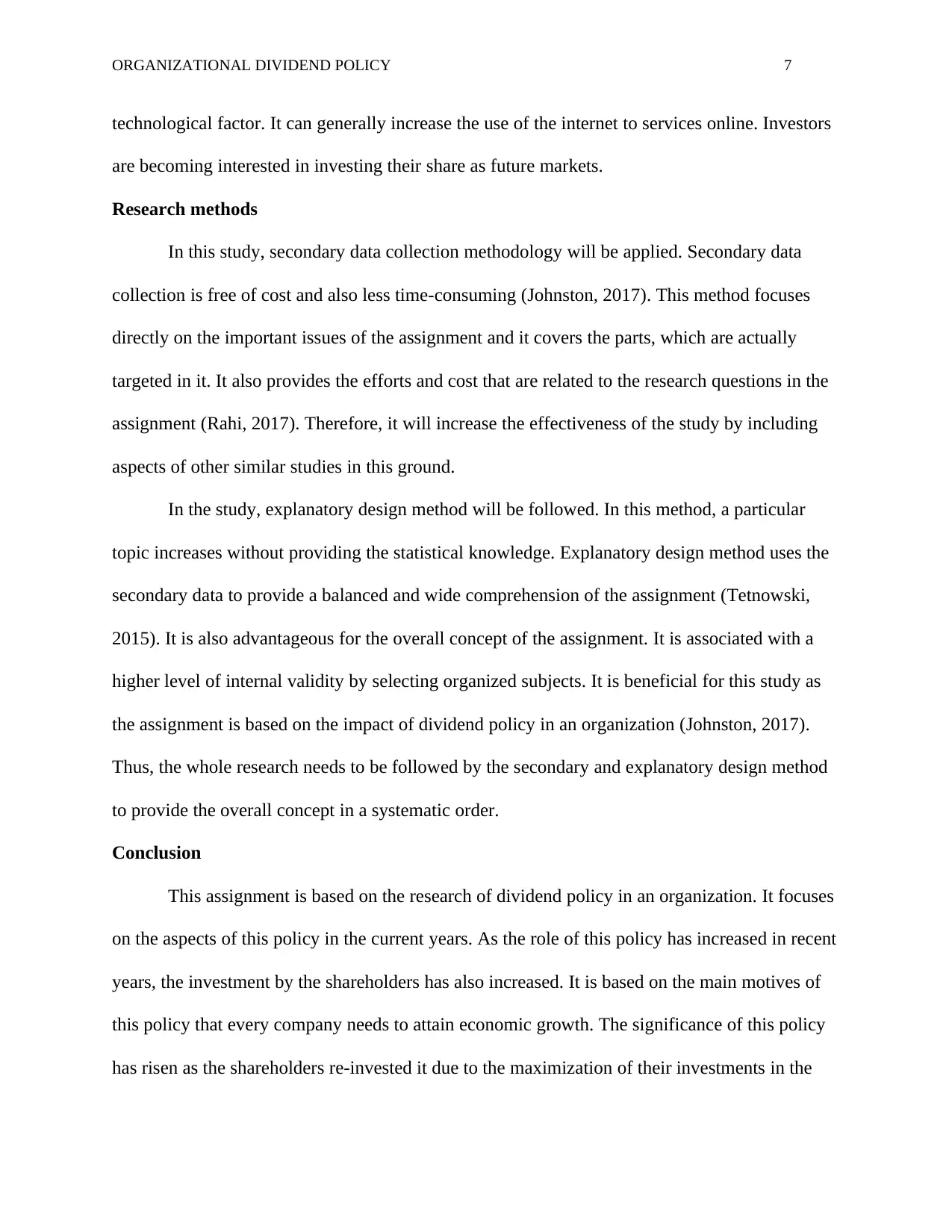
ORGANIZATIONAL DIVIDEND POLICY 7
technological factor. It can generally increase the use of the internet to services online. Investors
are becoming interested in investing their share as future markets.
Research methods
In this study, secondary data collection methodology will be applied. Secondary data
collection is free of cost and also less time-consuming (Johnston, 2017). This method focuses
directly on the important issues of the assignment and it covers the parts, which are actually
targeted in it. It also provides the efforts and cost that are related to the research questions in the
assignment (Rahi, 2017). Therefore, it will increase the effectiveness of the study by including
aspects of other similar studies in this ground.
In the study, explanatory design method will be followed. In this method, a particular
topic increases without providing the statistical knowledge. Explanatory design method uses the
secondary data to provide a balanced and wide comprehension of the assignment (Tetnowski,
2015). It is also advantageous for the overall concept of the assignment. It is associated with a
higher level of internal validity by selecting organized subjects. It is beneficial for this study as
the assignment is based on the impact of dividend policy in an organization (Johnston, 2017).
Thus, the whole research needs to be followed by the secondary and explanatory design method
to provide the overall concept in a systematic order.
Conclusion
This assignment is based on the research of dividend policy in an organization. It focuses
on the aspects of this policy in the current years. As the role of this policy has increased in recent
years, the investment by the shareholders has also increased. It is based on the main motives of
this policy that every company needs to attain economic growth. The significance of this policy
has risen as the shareholders re-invested it due to the maximization of their investments in the
technological factor. It can generally increase the use of the internet to services online. Investors
are becoming interested in investing their share as future markets.
Research methods
In this study, secondary data collection methodology will be applied. Secondary data
collection is free of cost and also less time-consuming (Johnston, 2017). This method focuses
directly on the important issues of the assignment and it covers the parts, which are actually
targeted in it. It also provides the efforts and cost that are related to the research questions in the
assignment (Rahi, 2017). Therefore, it will increase the effectiveness of the study by including
aspects of other similar studies in this ground.
In the study, explanatory design method will be followed. In this method, a particular
topic increases without providing the statistical knowledge. Explanatory design method uses the
secondary data to provide a balanced and wide comprehension of the assignment (Tetnowski,
2015). It is also advantageous for the overall concept of the assignment. It is associated with a
higher level of internal validity by selecting organized subjects. It is beneficial for this study as
the assignment is based on the impact of dividend policy in an organization (Johnston, 2017).
Thus, the whole research needs to be followed by the secondary and explanatory design method
to provide the overall concept in a systematic order.
Conclusion
This assignment is based on the research of dividend policy in an organization. It focuses
on the aspects of this policy in the current years. As the role of this policy has increased in recent
years, the investment by the shareholders has also increased. It is based on the main motives of
this policy that every company needs to attain economic growth. The significance of this policy
has risen as the shareholders re-invested it due to the maximization of their investments in the
Paraphrase This Document
Need a fresh take? Get an instant paraphrase of this document with our AI Paraphraser
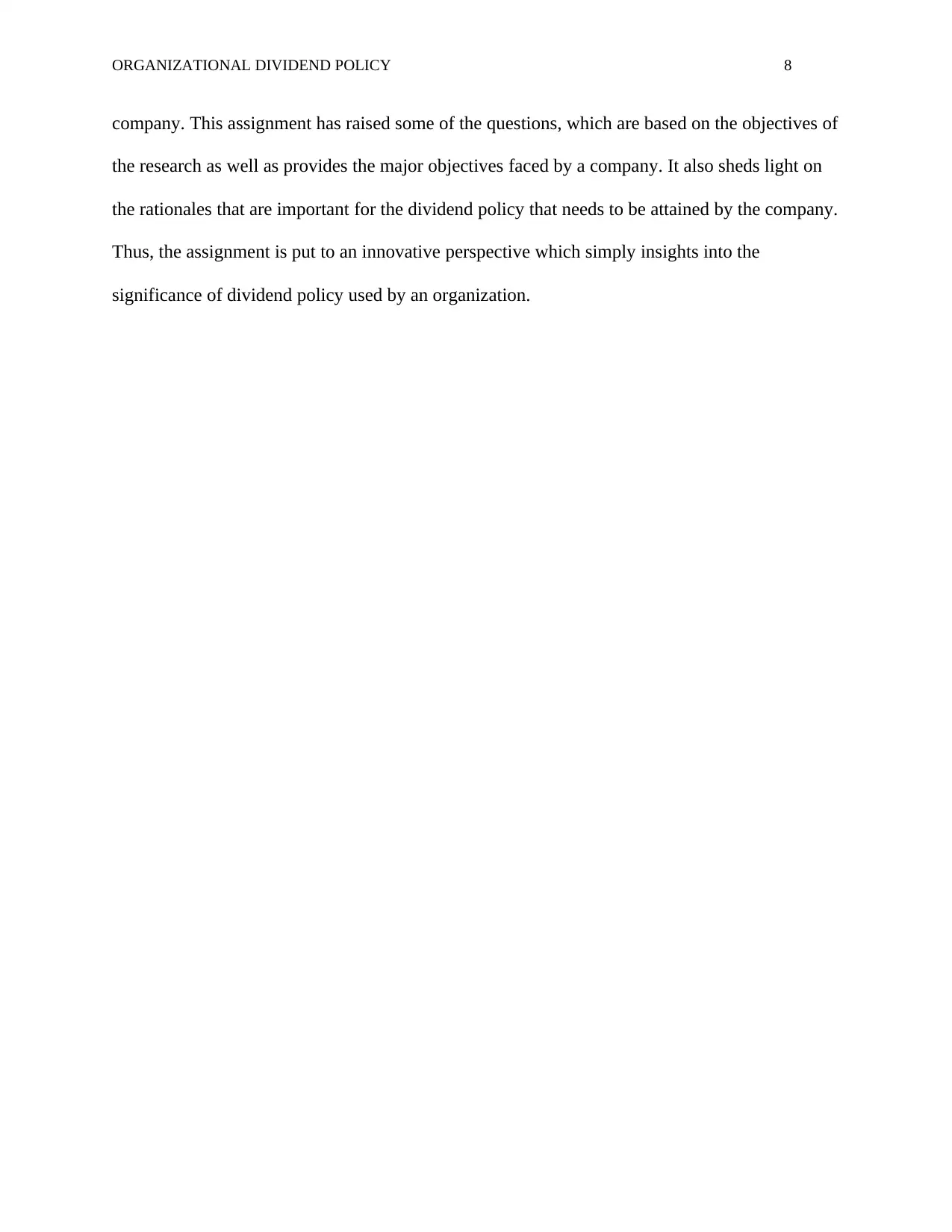
ORGANIZATIONAL DIVIDEND POLICY 8
company. This assignment has raised some of the questions, which are based on the objectives of
the research as well as provides the major objectives faced by a company. It also sheds light on
the rationales that are important for the dividend policy that needs to be attained by the company.
Thus, the assignment is put to an innovative perspective which simply insights into the
significance of dividend policy used by an organization.
company. This assignment has raised some of the questions, which are based on the objectives of
the research as well as provides the major objectives faced by a company. It also sheds light on
the rationales that are important for the dividend policy that needs to be attained by the company.
Thus, the assignment is put to an innovative perspective which simply insights into the
significance of dividend policy used by an organization.
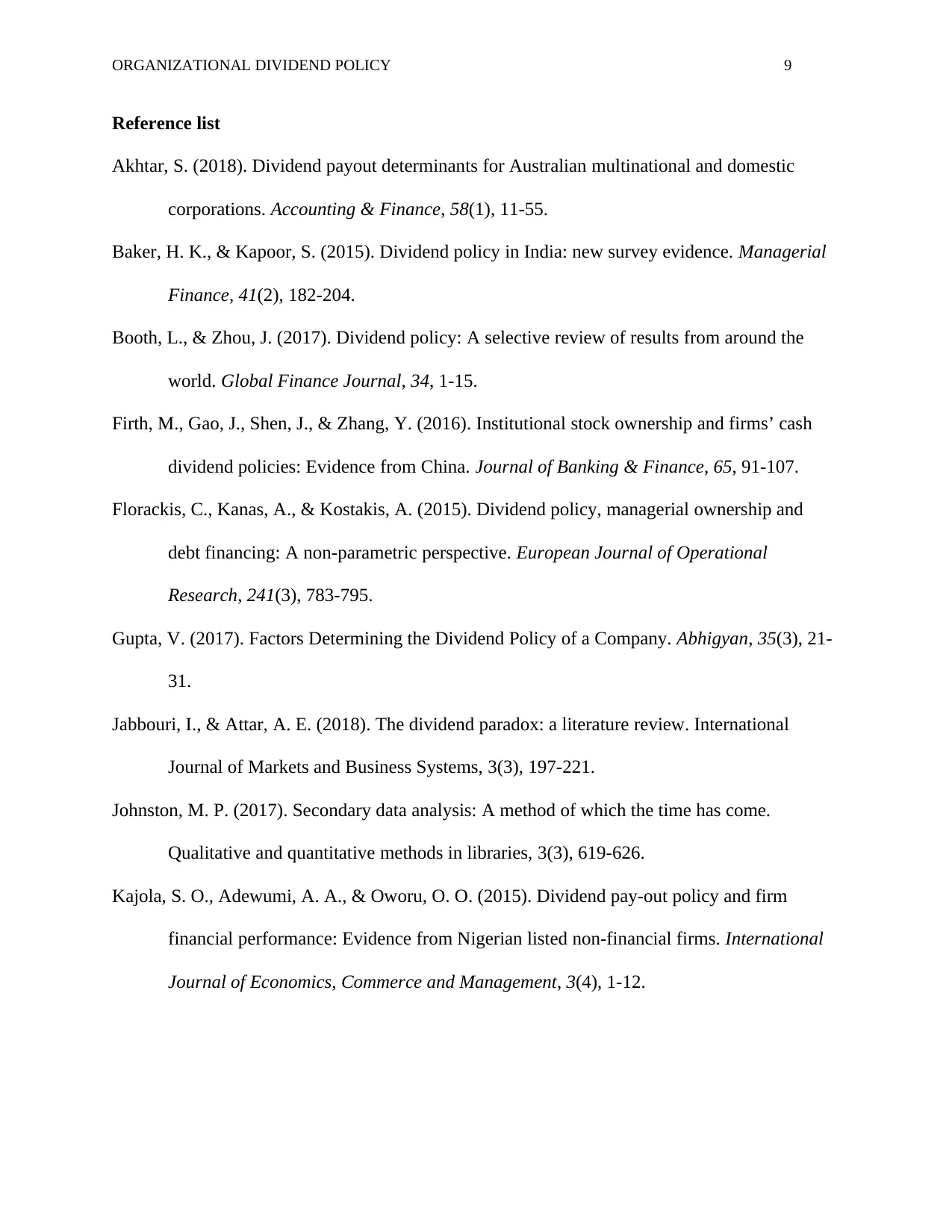
ORGANIZATIONAL DIVIDEND POLICY 9
Reference list
Akhtar, S. (2018). Dividend payout determinants for Australian multinational and domestic
corporations. Accounting & Finance, 58(1), 11-55.
Baker, H. K., & Kapoor, S. (2015). Dividend policy in India: new survey evidence. Managerial
Finance, 41(2), 182-204.
Booth, L., & Zhou, J. (2017). Dividend policy: A selective review of results from around the
world. Global Finance Journal, 34, 1-15.
Firth, M., Gao, J., Shen, J., & Zhang, Y. (2016). Institutional stock ownership and firms’ cash
dividend policies: Evidence from China. Journal of Banking & Finance, 65, 91-107.
Florackis, C., Kanas, A., & Kostakis, A. (2015). Dividend policy, managerial ownership and
debt financing: A non-parametric perspective. European Journal of Operational
Research, 241(3), 783-795.
Gupta, V. (2017). Factors Determining the Dividend Policy of a Company. Abhigyan, 35(3), 21-
31.
Jabbouri, I., & Attar, A. E. (2018). The dividend paradox: a literature review. International
Journal of Markets and Business Systems, 3(3), 197-221.
Johnston, M. P. (2017). Secondary data analysis: A method of which the time has come.
Qualitative and quantitative methods in libraries, 3(3), 619-626.
Kajola, S. O., Adewumi, A. A., & Oworu, O. O. (2015). Dividend pay-out policy and firm
financial performance: Evidence from Nigerian listed non-financial firms. International
Journal of Economics, Commerce and Management, 3(4), 1-12.
Reference list
Akhtar, S. (2018). Dividend payout determinants for Australian multinational and domestic
corporations. Accounting & Finance, 58(1), 11-55.
Baker, H. K., & Kapoor, S. (2015). Dividend policy in India: new survey evidence. Managerial
Finance, 41(2), 182-204.
Booth, L., & Zhou, J. (2017). Dividend policy: A selective review of results from around the
world. Global Finance Journal, 34, 1-15.
Firth, M., Gao, J., Shen, J., & Zhang, Y. (2016). Institutional stock ownership and firms’ cash
dividend policies: Evidence from China. Journal of Banking & Finance, 65, 91-107.
Florackis, C., Kanas, A., & Kostakis, A. (2015). Dividend policy, managerial ownership and
debt financing: A non-parametric perspective. European Journal of Operational
Research, 241(3), 783-795.
Gupta, V. (2017). Factors Determining the Dividend Policy of a Company. Abhigyan, 35(3), 21-
31.
Jabbouri, I., & Attar, A. E. (2018). The dividend paradox: a literature review. International
Journal of Markets and Business Systems, 3(3), 197-221.
Johnston, M. P. (2017). Secondary data analysis: A method of which the time has come.
Qualitative and quantitative methods in libraries, 3(3), 619-626.
Kajola, S. O., Adewumi, A. A., & Oworu, O. O. (2015). Dividend pay-out policy and firm
financial performance: Evidence from Nigerian listed non-financial firms. International
Journal of Economics, Commerce and Management, 3(4), 1-12.
⊘ This is a preview!⊘
Do you want full access?
Subscribe today to unlock all pages.

Trusted by 1+ million students worldwide
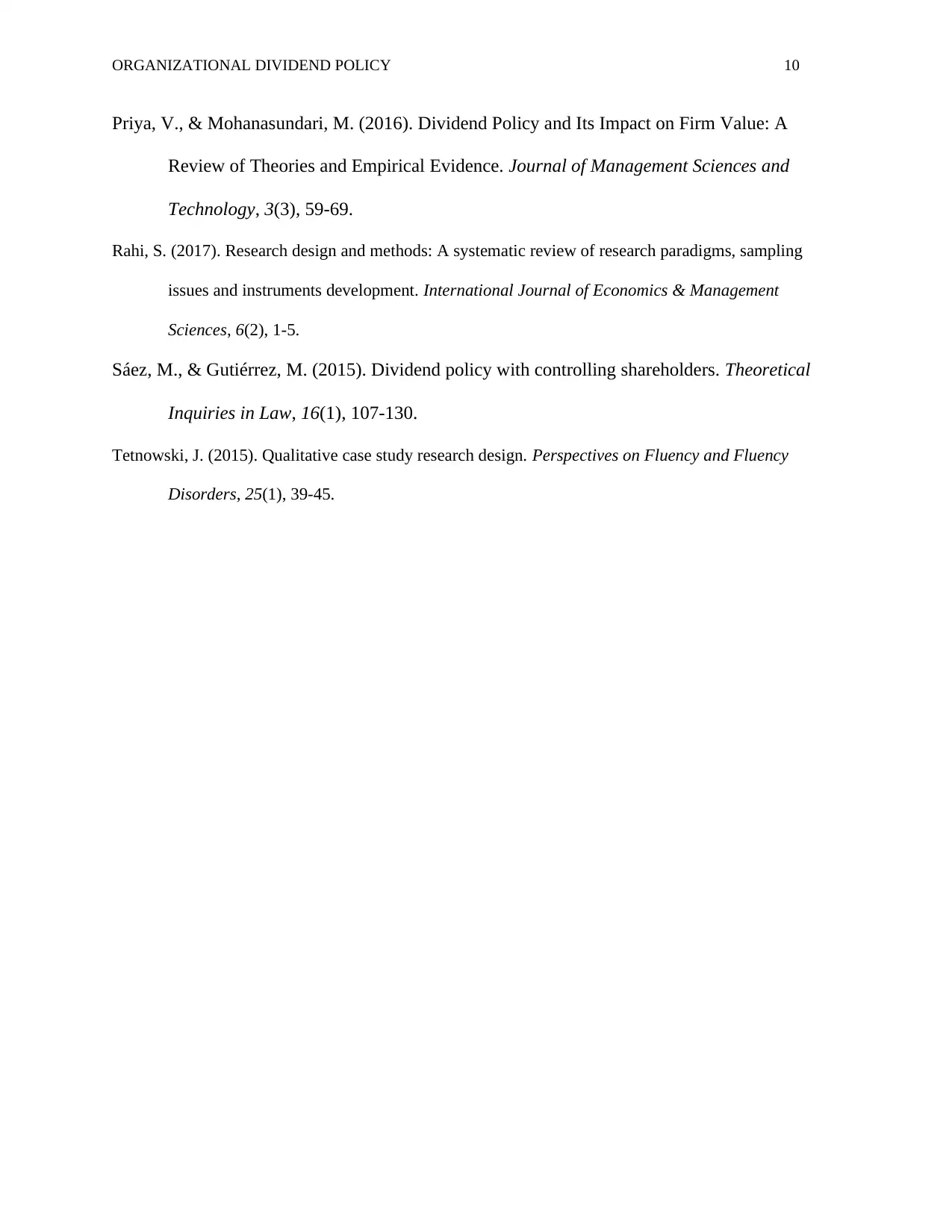
ORGANIZATIONAL DIVIDEND POLICY 10
Priya, V., & Mohanasundari, M. (2016). Dividend Policy and Its Impact on Firm Value: A
Review of Theories and Empirical Evidence. Journal of Management Sciences and
Technology, 3(3), 59-69.
Rahi, S. (2017). Research design and methods: A systematic review of research paradigms, sampling
issues and instruments development. International Journal of Economics & Management
Sciences, 6(2), 1-5.
Sáez, M., & Gutiérrez, M. (2015). Dividend policy with controlling shareholders. Theoretical
Inquiries in Law, 16(1), 107-130.
Tetnowski, J. (2015). Qualitative case study research design. Perspectives on Fluency and Fluency
Disorders, 25(1), 39-45.
Priya, V., & Mohanasundari, M. (2016). Dividend Policy and Its Impact on Firm Value: A
Review of Theories and Empirical Evidence. Journal of Management Sciences and
Technology, 3(3), 59-69.
Rahi, S. (2017). Research design and methods: A systematic review of research paradigms, sampling
issues and instruments development. International Journal of Economics & Management
Sciences, 6(2), 1-5.
Sáez, M., & Gutiérrez, M. (2015). Dividend policy with controlling shareholders. Theoretical
Inquiries in Law, 16(1), 107-130.
Tetnowski, J. (2015). Qualitative case study research design. Perspectives on Fluency and Fluency
Disorders, 25(1), 39-45.
1 out of 10
Related Documents
Your All-in-One AI-Powered Toolkit for Academic Success.
+13062052269
info@desklib.com
Available 24*7 on WhatsApp / Email
![[object Object]](/_next/static/media/star-bottom.7253800d.svg)
Unlock your academic potential
Copyright © 2020–2025 A2Z Services. All Rights Reserved. Developed and managed by ZUCOL.





